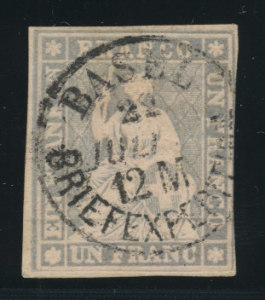In many ways, Swiss philately tells the story of Central European stamp collecting since 1970. Switzerland was one of the first stamp issuers, and, like the Postmaster Provisionals of the United states, the first stamps of Switzerland were issued by cities and states, rather than by the Federal Swiss government. Collectors esteemed Swiss stamps from the beginning, and the classic issues are among the most sought after stamps.
The collecting of Switzerland has changed dramatically in the last thirty years, and this reflects what has happened to classic philately in general. Fewer collectors today go in for highly specialized country collecting. As listed by the specialized Zumstein catalog, Switzerland can be collected by paper type, and a nearly endless range of perforation varieties are present in the late nineteenth century issues. There are fluorescent stamps in the twentieth century and coils and booklet panes combinations. In all, by Scott, there are over 3,000 different major Swiss stamps that need to be collected before the collector begins to concentrate on varieties. By the specialized Zumstein catalog, there are over 6,000 major varieties.
Switzerland is a wealthy country but a small one. In the first part of the twentieth century, most Swiss boys (along with most German, Austrian, and other Central European boys) collected stamps the way most American boys today have an interest in fantasy football. Philately then, in those countries, was so pervasive that kids who really had little interest played along just to belong. But today, Switzerland's population of 8,000,000 isn't big enough to support the price levels that Swiss stamps had attained when the country had a million philatelists. As stamp collecting rates in Central Europe have receeded more to general worldwide levels of philatelic interest, prices of Swiss stamps have fallen, and may continue to do so. In this regard, Swiss stamps (and German and Austrian) have been a victim of their own success.

